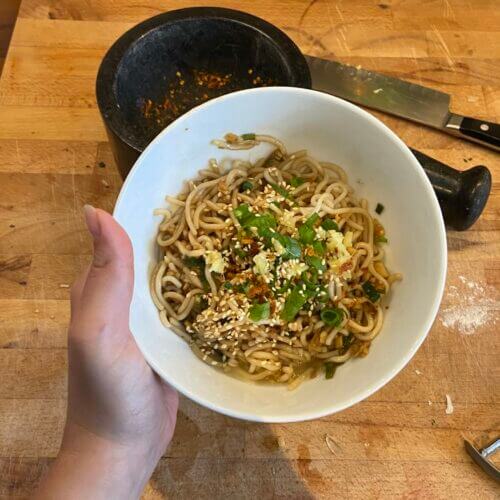Super Easy Chinese-inspired Aglio e Olio Pasta
Best known as simply aglio e olio in the UK, traditionally called pasta aglio, olio e peperoncino = garlic, olive oil, and chilli flakes pasta. It’s what I would liken to an Italian PB&J, in that it’s what Italians throw together when they want to eat something quick and easy (or when they come home hungry after a late night out).
The key to the Italian dish is infusing the oil with garlic. It’s as simple as it is delicious.
With that in mind, we thought we’d add ginger and black Chinese rice vinegar (Chiankiang) to turn this into a more Chinese-inspired dish. Instead of spaghetti, we used Amoy’s Straight to Wok Medium™ noodles, but really any will do (chow mein, udon, or even instant ramen noodles). See notes below for more info.
As a disclaimer, we make no pretences to authenticity on Asian cuisine – we just thought to adapt a traditional Italian aglio e olio with some other ingredients and see what would come out of it.
And on a side note, if you find yourself always in need of scallions at the wrong time, we revealed a little trick on how to always have them at hand in our Tips to Avoid Food Waste post.

Chinese-inspired Aglio, Olio e Peperoncino Pasta
Equipment
- Wok or frying pan
- A bowl
- Chef's Knife
- A stirring utensil
- Peeler (optional)
Ingredients
- 300-400 g Noodles We use two servings of Amoy Straight to Wok Medium because you don't have to boil them, but any will do
- 2-3 tbsp Vegetable oil (sunflower, rapeseed, etc.) Most to be used for the garlic/ginger infusion, but use a bit to fry up noodles in the wok
- 8 cloves 3 cloves to be crushed, 5 cloves to be minced
- 4 inch Ginger, peeled and minced + 3-4 large slices
- 5 Scallions, only the green parts finely sliced ⅔ to be cooked, ⅓ for garnish
- 3 tbsp Soy sauce
- 2 tbsp Black rice vinegar (Chiankiang)
- 1 tsp Fish sauce
- Pepper To taste
- Chili Flakes To taste, the spicier the better (I used dried and crushed birdseye chilis)
- 2 tsp Pickled ginger, finely sliced (for garnish) If you don't have any, just reserve a bit of your minced ginger
- Roasted sesame seeds To taste
Instructions
- Pour some oil into a wok or frying pan and add the 3 cloves of crushed garlic and 3-4 sliced coins of ginger. Heat at medium-low for 5 mins.
- Remove ginger and garlic and increase heat to medium high for 2 mins. Put 2/3rds of your sliced scallions in a mixing bowl. Add the hot oil to the bowl to lowkey cook the scallions. They'll shrink and wilt a bit. If they turn brown or black your oil was too hot. Because they are baby onions, scallions are more delicate than their older siblings, which is why you can't cook them directly over heat. Let them further infuse the oil for 5 mins.
- Once sufficiently infused, add the minced garlic and ginger (reserving a little bit of ginger for garnishing if you don't have any pickled ginger). Also add the soy sauce, black rice vinegar, and fish sauce. Add some chili flakes to taste here as well. Mix well and let sit for 10-15 mins so that all the ingredients mingle.
- Cook your noodles at some point during this. If using wok-fried noodles that don't require boiling, 5 mins in the wok over medium heat will do. Just add a bit of oil and wiggle the wok around to prevent sticking. If your noodles need to be boiled, most noodles of the Asian sort don't require much cooking time, so budget accordingly if you want to serve the dish hot. Be sure to read the packaging information. Once noodles are cooked, combine the sauce with the noodles in a wok over medium-low heat for 1-2 mins.
- Serve in a bowl or over a plate right away if you want the dish warm. Divvy up the remaining scallions and be sure to add pickled ginger if you've got it, or whatever bit of minced ginger remains. Throw the toasted sesame seeds on top. You can also throw the dish in the fridge and keep it there for up to 2-3 days and eat it cold. (You could probably reheat it too).
Quick thoughts on the ingredients
The black rice vinegar (the dominant brand seems to be Chiankiang) can be bought in large supermarkets, Asian markets, or online. It’s quite cheap and is a great item to have in your kitchen because it lasts forever and brings out a certain Cantonese flavour in certain dishes. If you don’t know what it tastes like, think back on the last time you had Chinese dumplings and remember the distinctive dipping sauce they’re served with: that’s ginger + black rice vinegar.
Fish sauce is another item that is cheap, lasts a long time, and elevates the quality of some Chinese and Southeast Asian cuisines substantially. It’s super common in Thai and Vietnamese food, but it works well in many other dishes.
I really can’t stress that any long noodle or pasta will do. Even Italian spaghetti will work, although in that case you might want to give a try to the traditional aglio e olio instead to not get any Italian friends angry.
Roasted peanuts would be a good shout for garnish in addition to (or to sub in for) the sesame seeds.
Post-noodles thoughts on aglio e olio
Traditional aglio olio e peperoncino spaghetti seems to have gained a lot of popularity outside of Italy in the past couple of years, at least in the UK. The biggest distinction between imitations and the real deal is the garlic-oil infusion.
While loads of non-Italians have been dressing their pasta with oil, garlic mince, and some chilli flakes and various herbs for ages, or sometimes even adding lemon, doing it the proper way gives it way more flavour. Aglio e olio seemed to have become very popular lately, which doesn’t surprise us.
This is, in fact, the way that many Italian dishes begin: with garlic cooking by itself at low heat in oil. Most times, garlic is actually discarded before eating, which may surprise a lot of non-Italians. Garlic in general isn’t used as much in Italian cuisine as you might think. And this is before talking about all the regional variations…
There is no one-fits-all rule in Italian cooking, but one thing is for certain: to learn how to cook proper, traditional Italian dishes, you have to find yourself surrounded by Italian people and just learn from the source. Or, at the very least, one of the sources.
